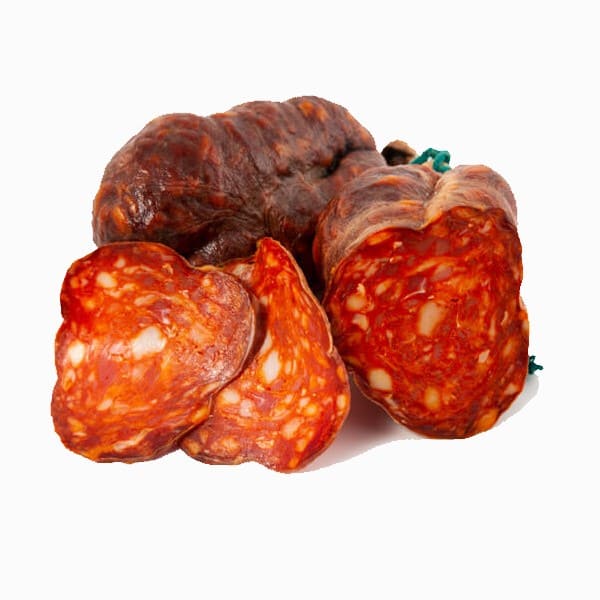Back to Cured Salami
Morcón
Morcón is a type of chorizo, eaten in much the same way. The difference is the meat with which it is made, which is usually lean without much fat content, and that the meat is stuffed into a section of pork large intestine.
The marinade used to flavor the chorizo is mainly composed of paprika, garlic, and salt. Due to the thickness of the sausage, the maturity period is quite long.
It is typical of some regions in Spain such as Andalucía, Salamanca, and Extremadura.
Categories: Cured Salami, SPANISH SMALLGOODS
Tags: chorizo morcon, morcon, spanish chorizo
Related products
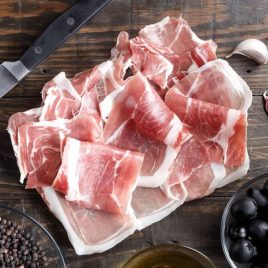
Serrano Ham
The majority of Serrano Jamones are made from a landrace breed of white pigs or from commercial breeds such as Duroc or Berkshire are not to be confused with the often more expensive jamón ibérico, made from black Iberian pigs.
These aged hams were known as a delicacy even in the days of the Roman Empire. The protein is of high quality and after curing for 12-14 months the meat becomes a rich intense red colour.
The serrano leg is always bigger than the Ibérico as it always contains less fat due to the different diets of each pig breed. Unlike the Italian prosciutto which is cured cold, the Spanish Jamones (ibérico & serrano) are cured in a specially ventilated room that mimics the conditions of the traditional cellar.
Jamón serrano can be used in a charcuterie board, in a bocadillo (crunchy bread roll), salad, stews, croquettes, pasta, pizza just about wherever your culinary imagination can take you.
Download our info sheet
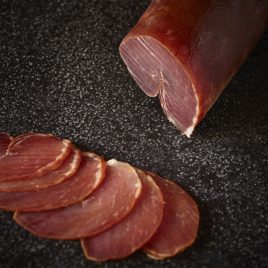
Lomo (Cured pork loin)
The lomo embuchado (pork loin) has its origin in Aragon (Spain), and is one of the cured meat products that have been protected under the Diputación de Aragón guarantee mark since 1993 in order to protect the quality of the product.
The preparation of the loin has been carried out in Aragon since ancient times. Originally the pork meat was obtained from the la matanza tradicional (traditional killings), now with the protection of the Diputación de Aragón guarantee mark ensures that the finest quality pork lion continues to be used as before.
The lomo embuchado of Aragon uses only the freshest meat free of the outer fat from castrated male pigs or females outside the estrus period, with salt and other natural spices marinated and then put into a sausage net. It is then allowed to mature for a maximum period of 60 days. The loin obtains an intense flavour, fine texture and is soft on the palate and is marketed with the seal of food quality. It comes in a ‘candle’ between 50 to 70 cm in length.
For their preparation, the loins are put to cure in salt and sugar for one or two days, then washed and left to air dry for a further two days until they are well drained. After the loin is marinated with a dressing prepared with paprika, garlic, oregano, and olive oil, they are put into elongated casings and hung for healing in a cool, dry environment for at least two to three months.
Its flavour is intense and natural, usually presented as a ‘candle’ or in thin slices cut vertically and vacuum packed, it then needs to be kept in a cool dry place. Its exterior colour is light and inside it has a dark vivid red colour with marble-like appearance, because of the fat that has infiltrated. The loin is consumed raw as it is a cured meat.
Tasting themes: Sliced thin in a crunchy baguette drizzled with a high-quality Spanish olive oil, in pinchos, on a charcuterie board.
Download our info sheet
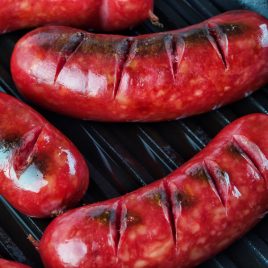
Hot / Mild Chorizo
The sausage has been around since ancient Greek and Roman times and in the 12th Century in the Romanesque Calendar of San Isidoro the month of November is called the month of the slaughter of the pigs with the pork being used for the making of chorizo and other cured and dried sausage such as the Chorizo parrillero. There are references in a famous ancient Greek comediographer, Artisphones’ literary works where the main character appeared with a pot full of sausages and with a figure of a man holding a pig for sausage making.
The chorizo acquired its characteristic red colour during the 16th Century when the paprika arrived from South America and was introduced into Spanish cuisine. In Spain, a chorizo must have garlic and paprika to be considered authentic since this is what differentiates Spanish chorizo from other sausages. It is cured outdoors or smoked, and its main base is minced pork marinated with paprika giving it its typical red colour and unmistakable full flavour.
Our chorizo is made not only from four types of pimentón with a mix of Spanish family secret herbs, it is also made from three different parts of the Linley Valley Pork – the jowl, cheek and shoulder. The pigs raised in Western Australia at Linley Valley Pork are fed on a nutritious diet of Australian grains, such as barley, wheat and lupins. This ensures a high-quality base from which The Iberians Chorizo is produced.
It has a diameter of 30-40 millimetres and string form, with a compact and firm consistency, rugged sexy appearance, smooth cut, red colour with an intense balanced aroma with a pleasant texture to the palate, and full lasting flavour, very balanced between fat and lean and includes the spicy variety.
In different regions of Spain the chorizo is cooked using a variety of methods – for instance in Galicia they serve the chorizo flamed in aguardiente (a fermented alcoholic herb liquor), in Asturias it is cooked a la sidra (with cider) or simply pan-fried in olive oil or on the BBQ.
Download our info sheet
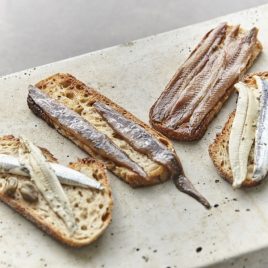
Pickled seafood
The boquerons (marinated anchovies) NASSARI are elaborated from the best prime material,obtained from our seas. Boquerons NASSARI is a fish that has been fished in the Mediterranean Sea, North Atlantic and the Cantabrian sea. They are produced by firstly being cleaned in abundant water, then marinated with wine vinegar and salt, this is how they obtain their characteristic flavour, colour and texture.
Product cleaned one by one, by hand.
The anchovy (Engraulis Encrasicolus) is obtained from the larger of the species, through a process inherited from the ancient Romans, salting. A gastronomic product of high quality, valued for it's characteristic aroma, obtained from a long process of salting. Throughout the salting process, the fish's own blood and a long process of curing, gives it it's own characteristic aroma. The anchovy is carefully filleted, and each fillet checked one by one to guarantee the quality of the product.
The anchovy (Engraulis Encrasicolus) is obtained from the larger of the species, through a process inherited from the ancient Romans, salting. A gastronomic product of high quality, valued for it's characteristic aroma, obtained from a long process of salting. Throughout the salting process, the fish's own blood and a long process of curing, gives it it's own characteristic aroma. The anchovy is carefully filleted, and each fillet checked one by one to guarantee the quality of the product.


